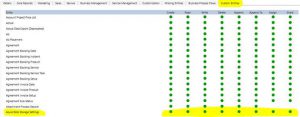Dynamics 365 Customer Engagement (aka Dynamics CRM) Attachment Management solution – Quick Q & A
Hello everyone!
Let me first wish you all a very happy and successful year, 2018.
Today, I am going to touch upon a common scenario within the Dynamics 365 Customer Engagement application, i.e. attachments, notes, annotations, images and all sort of attachments which you would have enabled in your application. This, from my experience, is inevitably taking a lot of space within your organization database. Especially when it comes to Online space, you are paying a lot for these attachments. Isn’t it? Or, you might be working on a proposal/solution where you would like to deliver an optimal and intuitive solution to your end users/customers from attachments perspective.
So, let me talk about one of the recent free solutions provided at the ‘AppSource’ which was previously known as the Dynamics Market Place. Among the many solutions available there, I am going to talk about the ‘Attachment Management’. Recently, I have been working with a few of my customers across Europe where I had an opportunity to work on Attachment Management PoCs (proof of concepts) for them. Hence, I thought of sharing my learnings and experiences with you all, which could be useful to you for taking your decision quickly on managing the attachments in Dynamics 365 Customer Engagement . Let’s keep in mind that the Dynamics 365 Customer Engagement Application is meant for managing your customers in the form of sales, services and marketing and we should not treat this as a document management application. So, it becomes important for you to consider this fact while designing a solution. Also, when you have an Online application tenant, you are required to pay for these attachments storage which is expensive than the blob storage on Azure. Thus, I would recommend you think twice before you decide to keep your attachments within the Dynamics 365 Customer Engagement application organization database.
Let me share my quick thoughts on the above-mentioned solution: (I am only touching upon the scenarios I encountered while working with my customers and I would suggest you to start with looking at the solution first, Attachment Management)
- What happens when we delete a record in CRM after configuring the Attachment Management solution – it deletes the associated attachments on the blob storage too.
- What are the ways of authenticating the Attachment Management solution with blob storage – this is completely and only based on SAS token at the moment.
- Does the solution provide image previews – yes, it does, like below. You could also have previews of word docs, ppts, xls and pdfs.
- Can we use this as a data source to pull records from blob storage – yes, we can use it like the way we pull any records from CRM using GUIDs (for example: https://<storage account name>.blob.core.windows.net/<container name>/<GUID>_<filename>). We will have to mitigate any authentication challenges though, if any.
- What happens to the existing attachments in the Dynamics 365 after configuration of attachment management solution - it starts moving the attachments to the blob automatically, but due to Dynamics 365 limitation of moving 140 records at a time, we would need to click on Move to Blob button, after every 140 records are moved. However, there is a solution to automate that too, which is using the logic apps, available on Github: https://github.com/anilvem1/LAMoveCRMAttachmentsToBlob . This will take care of the 140 limitations and move all the existing attachments automatically to the blob storage. Once all the existing attachments are moved, we don’t have to worry about moving the attachments manually or by using the logic apps, the Attachment Management will take care of moving all the attachments thereafter automatically. The logic apps solution which is built by one of the Microsoftians is required only initially to move all the existing attachments to the blob storage. Once all the attachments are moved, Attachment Management will handle attachments automatically by its own.
- Who could configure the attachment management solution in CRM – security is controlled by the Dynamics 365 security model which by default allows system administrators and customizers to make any changes, however this could also be controlled further by controlling the security roles in Dynamics 365.
- What happens once the attachments are moved to blob storage – Dynamics 365 Customer Engagement holds a reference to the moved attachments but the body (actual attachments) moves to the blob storage, freeing up the storage in the Dynamics 365 Customer Engagement organization database.
I guess, you would be now curious to test the solution and work on it, so I would highly recommend to refer the solution at https://appsource.microsoft.com/en-us/product/dynamics-365/microsoft_labs.96257e65-dbbe-43db-b775-77cf1609530c?tab=Overview . It includes a quick video about the configuration and usability, please do go through it to understand the solution well.
If you have any questions, I would encourage you to reach out to the Attachment Management support team at appsnotify@microsoft.com . I am always ready to answer your questions, but I know the Attachment Management is very active & supportive and you would be taken care of by them well.
Disclaimer:
This blog post is solely written based on my experiences and learnings. There could be other solutions as well which you might want to try out, but I haven’t reviewed them yet. The idea is to share my learnings and experiences so far on this solution.

